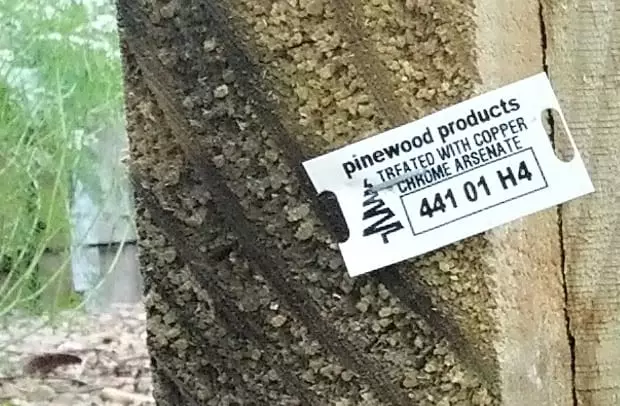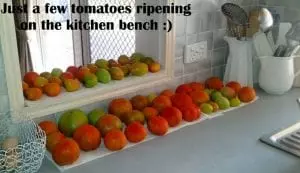I often get asked the question, is it safe to eat vegetables/fruit grown in garden beds made from treated wood/treated pine. Or, how do I know if my vegetable garden soil is contaminated or not and if so will my crops take-up these contaminants/chemicals thereby making them dangerous for my family and me to ingest.

Firstly, the reason wood is treated in the first place is to protect it from breaking down too quickly through pest or fungal attack. There are different strength levels of treatment usually classified from H1 through to H6 being the most effective and best preserved. Hardwoods have a natural protection against pest and fungal breakdown (because they are hard) and softwoods like pine are easy targets for pests because they are easier to eat. But hardwoods take a long time to grow whereas softwoods grow fast, are more sustainable and cheaper, therefore to balance out "fast grown softwood" and make it hardier it's often treated.
Chemicals used to treat wood are varied but commonly Chromate Copper Arsenate (CCA) is used and has been for about 80 years around the world because it's very effective at preserving wood from insects and fungi. In 2004, CCA treated wood was banned in Australia from being used in places where people might constantly come in contact with it such as playgrounds or park bench seating out of concerns arsenic from the treated wood may transfer to people. This ban wasn't meant to be interpreted as CCA treated wood is dangerous, moreover, it's a precaution taken by the government out of concerns that too much exposure through physical contact could lead to ingestion of arsenic, which may then cause health issues. To date, there's no scientific evidence that CCA treated wood has caused any illnesses in anyone in Australia.
Is treated wood safe to use in the vegetable patch?
The truth is there is no absolute definitive answer (that I know of via specific research I've found or my own experience) to whether arsenic, lead, or other contaminants used in the treatment of wood can leach into surrounding soils in quantities that could possibly negatively affect homegrown vegetables.
Interestingly, the NSW Environment Protection Agency on CCA treated wood states that "vegetable planters can be lined with plastic" but they give no further explanation and certainly don't warn against the use of CCA treated wood in food gardening. So, there are concerns that vegetables grown in treated wood garden beds could be hazardous but no concrete proof this is the case (if you know of any please advise and I'll update this article) but just because there isn't any real proof doesn't mean we shouldn't be cautious when working with or growing food crops around these types of products. In fact, manufacturers of treated woods clearly advise precautions to be taken when handling and/or working with their products. Although, these precautions are usually general, such as wash hands after handling treated wood, wear a face mask and eye protection when cutting wood, and wash off any sawdust from the skin ASAP to prevent irritation etc.
Nevertheless, we can still get an idea of how dangerous (or safe) treated woods (usually pine) are for growing vegetables because there is a lot of information out there on the process of treating wood and there have been some studies into the take-up of contaminants such as arsenic and lead by vegetable crops.
One such study I have come across is Arsenic and Lead Uptake by Vegetable Crops Grown on Historically Contaminated Orchard Soils done in 2013 by M. B. McBride Department of Crop and Soil Sciences, Cornell University, Ithaca, NY. This Research Article explains the study and testing undertaken to ascertain how much (if any) arsenic and lead was taken up by vegetables. The reason for the study in the first place was to see if crops that are grown on old reclaimed farming land (orchards) in the USA known to be contaminated by historically banned pesticides (in 1950's and 60's containing arsenic and lead) could be a health hazard.
Basically, the study (which included testing in a controlled environment) concluded by showing that only when vegetables were grown in soil with very high levels of arsenic and lead did the uptake exceed recommended international standards. Furthermore, fruiting vegetables such as tomatoes and beans were much less affected than root crops or salads such as carrots and lettuce because fruiting crops tended to exclude these elements when forming the fruit and root crops or salads were more physically exposed to these elements via direct contact with the contaminated soil. The full research article is here on the Hindawi Website if you want to check it out.
What does this mean? Well, you have to keep in mind that this study dealt with arsenic and lead that was delivered and dissolved into the soil by sprays and the levels of these contaminants needed to be high per kg of soil to pose any risk at all.
Arsenic used in treated timber, on the other hand, is not meant to leach out of the wood and is actually combined with chrome to prevent any leaching from happening. In other words, treated timber is designed to NOT contaminate the surrounding soil – that's an important point (if you believe it or not) because the study listed above specifically targets arsenic and lead that had contaminated the soil via liquid sprays and in significant quantities over a long period of time whereas we're talking about beds built with a product meant to protect the wood only from fungi and pests.
But let's say the treated timber does leach out some arsenic into the surrounding soil or even over time the timber breaks down and turns to dust – what then? Well, arsenic doesn't break down so it will remain in the soil, however, taking into consideration the results of the study I've cited, one could confidently conclude that the levels of arsenic contamination throughout the whole garden bed would probably be relatively low and therefore pose minimal risk.
Why? Assuming the raised garden bed built with treated wood was initially filled with good quality organic soil free from contaminates this would then allow plenty of room for dilution of any arsenic that may leach out mitigating the risk that a vegetable would be growing in soil with a high concentrate of arsenic anyway. Also, it's likely any arsenic leaching would not necessarily leach directly into the garden soil only and would probably also be distributed outside of the bed making it less concentrated. Lastly, the threat of arsenic ingestion (if it is present) can be significantly reduced through basic hygiene like washing hands after touching soil or CCA treated wood and cleaning or peeling vegetables before eating.
Logically, it seems unlikely a whole garden bed could become so contaminated by arsenic that it was deemed a health risk just because the bordering wood used was treated. Therefore, my conclusion based on my own research is that garden beds built with treated wood are probably safe to use for food crops without the worry that these crops may take up any harmful chemicals leached out into the soil and as a consequence poison anyone consuming them.
However, perception and prevention often trump facts and logic and sometimes for good reason or just simply for peace of mind. That's why I personally would use other materials or types of wood to build my raised beds that are deemed safe for vegetable gardens. I mean why take any chances?
Over 10 Years ago I built our first raised beds out of treated pine because there weren't many other options at the time (except for untreated wood) and I knew that wouldn't last very long on our property. Still, I decided to use builders plastic to line the inside of the beds in case any of the chemicals used to treat the wood leached out. We still have those beds today but as the sleepers degrade we've been replacing them with "safer" alternatives. So yes, I do have some treated wood garden beds and yes I'm aware but I'm not overly concerned about the potential health risk.
Question about treated wood and food gardening
Anyway, let's finish this article with an actual question I received yesterday (as at the writing of this post) by Debbie, she writes:
Q. Hi Mark, I'm moving forward with my tree change and am looking at buying a small country property. It already has a couple of timber raised garden beds but I'm worried they may have used treated timber. Is there any way of knowing or any signs to look for before planting food crops in them?
A. Thanks for the question Debbie. I know the actual question is asking how to tell if the wood is treated but the underlying question is also should you be concerned about leached arsenic in the soil so I'll address them both. Now, I've already written a whole article on this subject so I'll keep my answer brief… Firstly, you can't always tell if the wood has been treated and it's a mistake to think that just because you can't see any signs or smell any odour that the wood hasn't had a chemical treatment. If the wood is pine, I would assume it has been treated with something and if the beds look old then it probably has been treated with CCA.
Regardless, it's all academic because whether these beds pose any risk to health or not or whether your concerns are warranted or inflated if you grow vegetables in these beds you'll probably always think about it negatively and therefore not enjoy your food growing and eating experience as much as you should. Personally, if you still have an inkling of worry about these beds after reading my whole article, I would dispose of the beds altogether and replace the materials and soil. That way, you'll have complete peace of mind knowing your plot is as organic and chemical free as possible.
These days there are plenty of other materials in lieu of wood treated with suspect chemicals (like arsenic) to make raised vegetable gardens including Microshade treated wooden sleepers that are deemed safe for vegetable gardens and children's play areas but are still pest resistant, sustainable, and reasonably priced.
Perhaps you will repurpose those sleepers but if you decide to dispose of them completely do not chip or burn them because that is a no-no for CCA treated wood for obvious reasons.
I should also mention arsenic is a naturally occurring substance in soil, water, and even air so we likely ingest it in small quantities all the time. If it's ingested in abnormally high levels then humans will get ill but if you carry out a soil sample test don't be surprised to find traces of arsenic as this could be completely normal.
All the best 🙂













